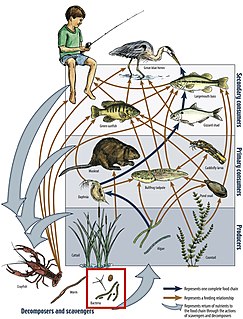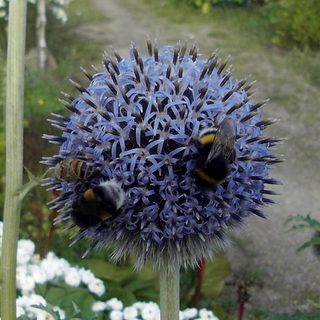
A food web is the natural interconnection of food chains and a graphical representation of what-eats-what in an ecological community. Another name for food web is consumer-resource system. Ecologists can broadly lump all life forms into one of two categories called trophic levels: 1) the autotrophs, and 2) the heterotrophs. To maintain their bodies, grow, develop, and to reproduce, autotrophs produce organic matter from inorganic substances, including both minerals and gases such as carbon dioxide. These chemical reactions require energy, which mainly comes from the Sun and largely by photosynthesis, although a very small amount comes from bioelectrogenesis in wetlands, and mineral electron donors in hydrothermal vents and hot springs. These trophic levels are not binary, but form a gradient that includes complete autotrophs, which obtain their sole source of carbon from the atmosphere, mixotrophs, which are autotrophic organisms that partially obtain organic matter from sources other than the atmosphere, and complete heterotrophs that must feed to obtain organic matter.

In statistical physics and mathematics, percolation theory describes the behavior of a network when nodes or links are added. This is a geometric type of phase transition, since at a critical fraction of addition the network of small, disconnected clusters merge into significantly larger connected, so-called spanning cluster. The applications of percolation theory to materials science and in many other disciplines are discussed here and in the articles network theory and percolation.

An apex predator, also known as an alpha predator or top predator, is a predator at the top of a food chain, without natural predators.
Trophic cascades are powerful indirect interactions that can control entire ecosystems, occurring when a trophic level in a food web is suppressed. For example, a top-down cascade will occur if predators are effective enough in predation to reduce the abundance, or alter the behavior of their prey, thereby releasing the next lower trophic level from predation.

In ecology, a community is a group or association of populations of two or more different species occupying the same geographical area at the same time, also known as a biocoenosis, biotic community, biological community, ecological community, or life assemblage. The term community has a variety of uses. In its simplest form it refers to groups of organisms in a specific place or time, for example, "the fish community of Lake Ontario before industrialization".
A guild is any group of species that exploit the same resources, or that exploit different resources in related ways. It is not necessary that the species within a guild occupy the same, or even similar, ecological niches. An ecological niche is defined as the role an organism plays in its community, i.e. decomposer, primary producer, etc. Guilds are defined according to the locations, attributes, or activities of their component species. For example, the mode of acquiring nutrients, the mobility, and the habitat zones that the species occupy or exploit can be used to define a guild. The number of guilds occupying an ecosystem is termed its disparity. Members of a guild within a given ecosystem could be competing for resources, such as space or light, while cooperating in resisting wind stresses, attracting pollinators, or detecting predators, such as happens among savannah-dwelling antelope and zebra.

The trophic level of an organism is the position it occupies in a food web. A food chain is a succession of organisms that eat other organisms and may, in turn, be eaten themselves. The trophic level of an organism is the number of steps it is from the start of the chain. A food web starts at trophic level 1 with primary producers such as plants, can move to herbivores at level 2, carnivores at level 3 or higher, and typically finish with apex predators at level 4 or 5. The path along the chain can form either a one-way flow or a food "web". Ecological communities with higher biodiversity form more complex trophic paths.
An ecological network is a representation of the biotic interactions in an ecosystem, in which species (nodes) are connected by pairwise interactions (links). These interactions can be trophic or symbiotic. Ecological networks are used to describe and compare the structures of real ecosystems, while network models are used to investigate the effects of network structure on properties such as ecosystem stability.
Graham R. Fleming is a Professor of Chemistry at the University of California, Berkeley and member of the Kavli Energy NanoScience Institute based at UCB.
Large ornamented Ediacaran microfossils are microscopic acritarchs, usually over 100 μm in diameter, which are common in sediments of the Ediacaran period, 635 to 541 million years ago. They largely disappear from the Ediacaran period fossil record before 560 million years ago, roughly coeval with the origin of the Ediacara biota. They differ from Palaeozoic microfossils in many respects; they are larger, often have internal contents, have a differently-constructed cell wall, and differ in shape.
The Lévy flight foraging hypothesis is a hypothesis in the field of biology that may be stated as follows:
Since Lévy flights and walks can optimize search efficiencies, therefore natural selection should have led to adaptations for Lévy flight foraging.
A food chain is a linear network of links in a food web starting from producer organisms and ending at an apex predator species, detritivores, or decomposer species. A food chain also shows how organisms are related to each other by the food they eat. Each level of a food chain represents a different trophic level. A food chain differs from a food web because the complex network of different animals' feeding relations are aggregated and the chain only follows a direct, linear pathway of one animal at a time. Natural interconnections between food chains make it a food web.

Susanne Sabine Renner is a German botanist. She is professor of biology at the Ludwig Maximilian University of Munich as well as director of the Botanische Staatssammlung München and the Botanischer Garten München-Nymphenburg.

A pollination network is a bipartite mutualistic network in which plants and pollinators are the nodes, and the pollination interactions form the links between these nodes. The pollination network is bipartite as interactions only exist between two distinct, non-overlapping sets of species, but not within the set: a pollinator can never be pollinated, unlike in a predator-prey network where a predator can be depredated. A pollination network is two-modal, i.e., it includes only links connecting plant and animal communities.
Elizabeth T. Borer is an American ecologist and a Professor of Ecology, Evolution and Behavior in the College of Biological Sciences at the University of Minnesota.

Membership of the National Academy of Sciences is an award granted to scientists that the National Academy of Sciences (NAS) of the United States judges to have made “distinguished and continuing achievements in original research”. Membership is a mark of excellence in science and one of the highest honors that a scientist can receive.
Charles Clifton Richardson is an American biochemist and professor at Harvard University. Richardson received his undergraduate education at Duke University, where he majored in medicine. He received his M.D. at Duke Medical School in 1960. Richardson works as a professor at Harvard Medical School, and he served as editor/associate editor of the Annual Review of Biochemistry from 1972 to 2003. Richardson received the American Chemical Society Award in Biological Chemistry in 1968, as well as numerous other accolades.
Ralph Stoner Wolfe was an American microbiologist, who contributed to the discovery of the single-celled archaea as the third kingdom of life. He was a pioneer in the biochemistry of methanogenesis.

The ecology of fear is a conceptual framework describing the psychological impact that predator-induced stress experienced by animals has on populations and ecosystems. Within ecology, the impact of predators has been traditionally viewed as limited to the animals that they directly kill, while the ecology of fear advances evidence that predators may have a far more substantial impact on the individuals that they predate, reducing fecundity, survival and population sizes. To avoid being killed, animals that are preyed upon will employ anti-predator defenses which aid survival but may carry substantial costs.
The Hynes Award is awarded by the Society for Freshwater Science and recognizes an excellent academic research paper in the freshwater sciences by a scientist less than five years after their terminal graduate degree. Recipients of the award have gone on to become leading senior researchers, serving as science advisors to various governments and states, and held leadership positions in national and international scientific societies.









